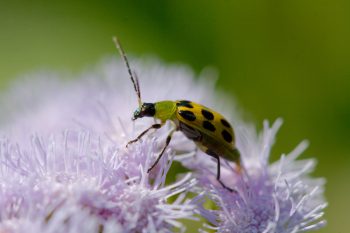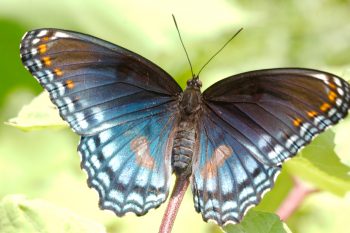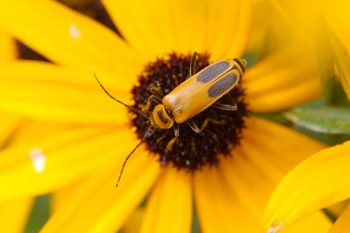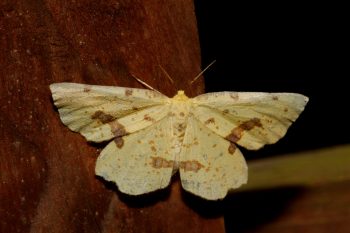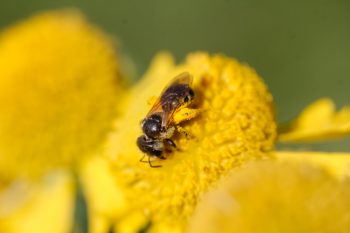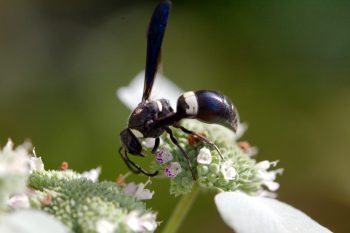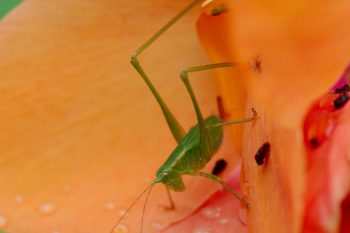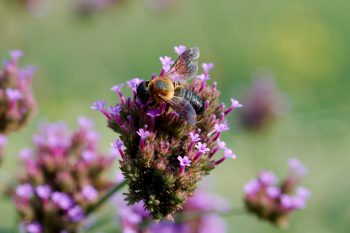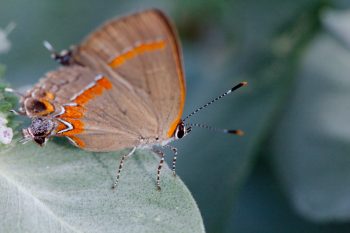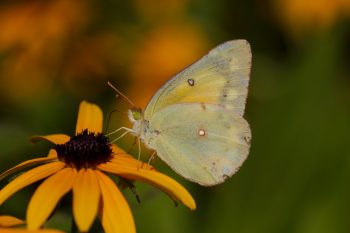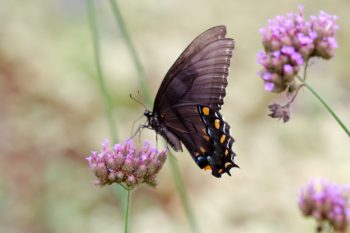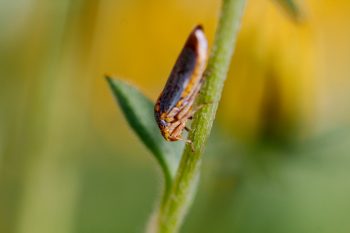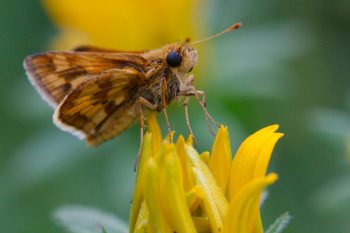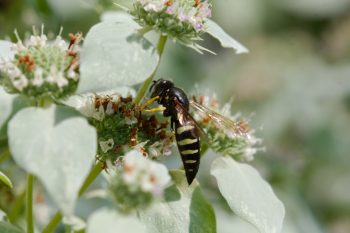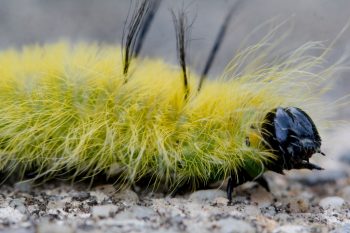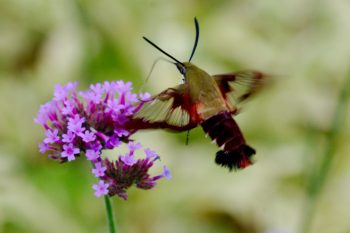I was down on the ground taking some photos of a skipper on some blue mistflower (Conoclinium coelestinum) when I noticed this spotted cucumber beetle (Diabrotica undecimpunctata) just to my right. I got a handful of photos of it before it flew away and I actually got a fairly good one of it just taking off. I think this is a better picture, overall, though, so I thought I’d use it. This is a destructive insect and really I should have squashed it, but it flew away before I had the chance. They do significant damage to many field crops “including cucumbers and other squashes, corn, soy.”
Creatures
Diabrotica undecimpunctata (Spotted Cucumber Beetle)
Limenitis arthemis astyanax (Red-spotted Purple)
We took an outing today to Rocklands Farm and Winery and had a lovely visit with Janis. She and Anna took us to see Anna’s flowers and then we circled back around behind the winery. The grape must that had spilled on the ground outside the work area had attracted quite a few butterflies, including this red-spotted purple (Limenitis arthemis astyanax). To me, it looks more like an orange-spotted blue, but what do I know. Their colors are a bit variable, anyway. Nevertheless, this is a pretty distinctive butterfly and always a treat to see.
Vulcan
Dorothy asked if we’d host a dinner for the Fourth Fellows this evening and we did, with all but one of them coming. I made a pretty large batch of spaghetti sauce and we all ate out on the back patio. The plan was for them to stay outside but when the rain started we had them move indoors. Sarah asked if she could bring her dog with her and we said yes. This is Vulcan. He’s a large but relatively gentle creature with a face that reminds me a bit of Scooby-Doo.
Chauliognathus pensylvanicus (Goldenrod Soldier Beetle)
This goldenrod soldier beetle, (Chauliognathus pensylvanicus) is well camouflaged against the petals of the black-eyed Susan in our back yard. Often when looking for insects, it’s a matter of looking for motion, because they blend in so well with the background. I spotted this on after taking a few photos of a monarch butterfly (Danaus plexippus), also on the black-eyed Susans. They are starting to fade, but there will still be plenty of color for a while yet. One interesting thing about this beetle is that the species epithet, pensylvanicus, is the correct spelling and the version with a double n (i.e. pennsylvanicus) is incorrect.
Xanthotype Species
We went to Northern Virginia this evening to have dinner with our good friend, Jean. While we were there, eating in her car port, there was a huge downpour followed by a rainbow. It was actually really nice to be sitting outside but under cover during that. Then, I happened to spot this moth, which landed on the gate to the back yard. It’s a moth in the genus Xanthotype. There are five species in our area but, according to BugGuide, “adults of all species in this genus are, for practical purposes, externally indistinguishable from one another” so we’ll just leave it at that.
Pollinator
This little bee is absolutely loaded with pollen. (Side question: if pollen is spelled with an ‘e’, why does pollinator have an ‘i’ in its place?) Anyway, Cathy and I went to Meadowside Nature Center this afternoon and walked around a pond and through the woods. In addition to this little bee, I got a pretty good photo of a common whitetail (Plathemis lydia), a fairly common dragonfly. But I thought I’d go with the bright yellow of this photo instead. I’m also partial to bees, of course.
Monobia quadridens (Four-toothed Mason Wasp)
The mountain mint is really buzzing these days. The height of summer is really great for seeing bees and wasps and I really enjoy seeing them in the afternoon. The sun beating down it a bit much so I can only take it for short stretches but it’s worth it to see the variety of stinging things buzzing around. This is, I believe, a four-toothed mason wasp (Monobia quadridens). The larvae feed on leaf-rolling caterpillars so are generally considered good to have around. Their sting is something you want to avoid but like most hornets and wasps, if you leave them alone, they’ll leave you alone.
Spicebush Swallowtail (Papilio troilus)
I’m pretty sure this is a spicebush swallowtail (Papilio troilus). There are three dark swallowtails that we see somewhat regularly. Most of them are dark form females of the eastern tiger swallowtail (Papilio glaucus). This is, in my experience, the second most common. Then there are the black swallowtails (Papilio polyxenes). They all look pretty similar and they all have a bit of variation in their coloration. Since I’m really not an expert, I could be wrong about this one. I’ll just leave it at that. It’s a pretty butterfly, in any case, and is enjoying the blue lobelia (Lobelia siphilitica ) in our front garden.
Scudderia Nymph
I noticed this bright green katydid nymph on the canna lily this morning. It is one of the Scudderia species. It let me get pretty close, as you can see and it actually stayed there for a few days and ate a good amount of the petals on this flower. Generally I’m not a fan of flower-eating insects but this one was pretty enough and eating slowly enough that I let it be. I like the green against the orange of the petals and even though it’s a small thing, I could see it clearly from our kitchen door, which was nice.
Megachile sculpturalis (Sculptured Resin Bee)
I’m pretty sure this is a sculptured resin bee (Megachile sculpturalis), a fairly common, solitary bee in the Megachilidae family (the leafcutter, mason, and resin bees, and allies). We see them on a variety of flowers in our yard. This one is on the Verbena bonariensis (tall verbena or Brazilian vervain) and that seems to be a favorite for these bees. Like most bees, they are not at all agresive and much more likely to fly away from you than bother you in any way. I think they’re quite pretty, with their furry thorax and sculptured abdomen.
Calycopis cecrops (Red-banded Hairstreak)
This is a pretty little butterfly that I don’t see too often in our yard. It is, I believe, a red-banded hairstreak (Calycopis cecrops). It was moving about amongst the mountain mint (Pycnanthemum muticum) and that made it hard to get a clear photo of it, but this one turned out pretty well. The hairstreaks are a subfamily (and considered as a tribe) under the Lycaenidae, the Blues, Coppers, Hairstreaks, and Harvesters. They are smallish butterflies and their “eye spots” at the far end of their hind wings presumably fool prediters into thinking that’s their head enough to improve their chance of survival.
Orange Sulphur
I’m not actually 100% sure of the identification of this sulphur. It may be an orange sulphur (Colias eurytheme) but it’s hard to tell for sure from the underside of the wings. It’s a sulphur, anyway, subfamily Coliadinae. I’ve had a hard time getting a good photograph of one, as they are quite shy and often don’t land when I’m near by. So, I was pleased to get this photo and a few others today. It’s a pretty little butterfly and I love seeing them on the flowers in the yard.
Tiger Swallowtail (Papilio glaucus)
We have a lot of tiger swallowtails (Papilio glaucus) in our yard. The particularly like the butterfly bush (Buddleia) but we see them on other flowers, as well. They are often quite ragged, with torn wings and sometimes with less than half remaining. Nevertheless, they seem to get around alright. Most of them are the standard yellow striped with black but we have a significant number of the dark form, which is restricted to females of the species. This is a pretty nice one, with her wings mostly intact. As you can see, she is on a tall verbena (Verbena bonariensis).
Oncometopia orbona (Broad-headed Sharpshooter)
I took some photos of flowers today as well as a few of tiger swallowtails. But then I saw this little insect. It’s a leafhopper and they aren’t very big. I got two decent photos of it, one with the head and eyes in focus (this one) and the other with the body in focus but the head blurred. Nevertheless, it was enough to let it be identified as a Broad-headed Sharpshooter (Oncometopia orbona). There are four species of Oncometopia in the U.S.A. but this is the only one that’s known to be present here, so I’m pretty sure that’s right. It’s a pretty little critter.
Monarch on Butterfly Weed
The monarch (Danaus plexippus) is one of the prettiest butterflies we get. They don’t show up in nearly as great numbers as do the tiger swallowtails (Papilio glaucus) and maybe that’s what makes their appearance more exciting. This one was on a tender butterfly weed (Asclepias curassavica) that it in a container on our back patio. I took this one photo from the lawn side of the patio before trying to get around to the other side. Just as well because it flew off after that and I got no more. I did take some more photos of the tiger swallowtails but I’m sure I’ll get more of them this summer.
Polites peckius (Peck’s Skipper)
The skippers are here in their great numbers. They aren’t flashy like the swallowtails and they don’t buzz like the bees, but they are everywhere. They especially like the black-eyed Susan flowers (as seen here) and the Verbena bonariensis but they can also be seen on other plants. This is, I believe, a Peck’s skipper (Polites peckius), also known as the yellow patch or yellow spotted skipper. The larvae feed on grasses while the adults take nectar from flowers. They are widespread across much of North America.
Bicyrtes quadrifasciatus
This is a sand wasp, Bicyrtes quadrifasciatus I believe. It’s fairly common although nothing like the western honey bee or the bumble or carpenter bee, but I see them quite a bit on the mountain mint (Pycnanthemum muticum), as this one is. If I go out in the heat of the day, with the sun beating down on the mountain mint, it’s an absolute hive of activity (and I mean that in the most literal sense). There are myriad bees and wasps buzzing around with an occasional skipper sneaking in. The buddleia above has mostly bumble and carpenter bees as well as butterflies. Now and then I spot a true bug of one sort or another. It’s really wonderful, unless of course you are allergic or simply afraid of stinging things. It’s also very hot so I don’t generally stay out too long, but I love it.
American Dagger Moth Caterpillar (Acronicta americana)
Cathy called me up from the basement this morning because she thought I might like to see this caterpillar on our back patio. It was crawling along the hose but then moved off onto some leaves and sticks, which looks a bit more natural. It is an American Dagger Moth Caterpillar (Acronicta americana). They feed on the leaves of various deciduous trees so I really shouldn’t have let it live, but I did. Apparently the hairs can cause skin irritation, so it’s something you probably don’t want to handle. I didn’t, so I cannot say whether or not it’s a serious problem.
Sneezeweed (Helenium ‘Mardi Gras’)
Cathy bought a few perennials over the weekend and I planted this one yesterday. It’s a sneezeweed called ‘Mardi Gras’ and it’s really nice. The flowers have a similar look to black-eyed Susans but it’s a different genus (Helenium). I happened to catch it with a little, green-sweat bee on it, which is a bonus. It prefers somewhat barren ground and isn’t supposed to do well in heavy clay, which is probably why I haven’t seen it around here. That’s really all we have. But hopefully it will survive, even if it doesn’t thrive too well.
Snowberry Clearwing (Hemaris diffinis)
After we got home from visiting mom this afternoon we were sitting in the front yard. The evenings have been warm but so much nicer than it’s been during the heat of the day. Because my work setup is in the basement, I feel like I need to get outdoors some each day so I’m going out front after work to read. Today wasn’t a work day, but I sat out anyway. I had just taken a photo of the tiger lily buds when we spotted this snowberry clearwing moth (Hemaris diffinis) on the Verbena bonariensis. I didn’t really have great light for taking pictures of a moth on the wing (and these rarely land, preferring to hover). But this one turned out pretty well, I think.

